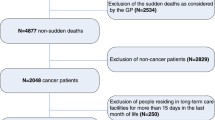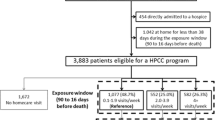Abstract
Objective: To estimate the reduction of time spent in hospital obtained through palliative home care. Methods: Retrospective analysis of the hospital admissions occurred during the last year of life. Cancer patients who were resident in the province of Florence, were registered at the Tuscan Cancer Registry, and died during the year 1997 were included in the study. Three palliative home care services were operating in the study area in 1997. Main results: 3423 cancer patients died in the study area during 1997. 9.2% of them received palliative home care. Palliative home care was effective in reducing the utilization of hospital care during the last three months of life. A 25% reduction of the relative risk (CI: 34–14%) to have in-patient admissions and a 49% reduction of relative risk (CI: 52–47%) of spending days in the hospital during the last 3 months of life were estimated through multivariable regression models. Conclusions: Palliative home care was effective in reducing time spent in hospital during the last 3 months of life.
Similar content being viewed by others
References
Eve A,Smith AM,Tebbit P (1997) Hospice and palliative care in the UK 1994-5, including a summary of trends 1990-5. Palliat Med 11: 31-43.
Quill TE (2002) In-hospital end-of-life services: is the cup 2/3 empty or 1/3 full? Med Care 40: 4-6.
von Gunten CF (2002) Secondary and tertiary palliative care in US hospitals. JAMA 287: 875-881.
Hearn J,Higginson IJ (1998) Do specialist palliative care teams improve outcomes for cancer patients? a systematic literature review. Palliat Med 12: 317-332.
Costantini M,Toscani F,Gallucci M, et al. (1999) Terminal cancer patients and timing of referral to palliative care: a multicenter prospective cohort study. Italian Cooperative Research Group on Palliative Medicine. J Pain Symptom Manage 18: 243-252.
Ventafridda V,Tamburini M,Selmi S,Valera L,De Conno F (1985) The importance of a home care programme for patients with advanced cancer. Tumori 71: 449-454.
Wilkinson EK,Salisbury C,Bosanquet N, et al. (1999) Patient and carer preference for, and satisfaction with, specialist models of palliative care: a systematic literature review. Palliat Med 13: 197-216.
Rinck GC,van den Bos GA,Kleijnen J, et al. (1997) Methodologic issues in effectiveness research on palliative cancer care: a systematic review. J Clin Oncol 15: 1697-1707.
McQuay H,Moore A (1994) Need for rigorous assessment of palliative care. BMJ 309: 1315-1316.
Keeley D (1999) Rigorous assessment of palliative care revisited. Wisdom and compassion are needed when evidence is lacking. BMJ 319: 1447-1448.
Paci E,Miccinesi G,Toscani F, et al. (2001) Quality of life assessment and outcome of palliative care. J Pain Symptom Manage 21: 179-188.
Salisbury C,Bosanquet N,Wilkinson E, et al. (1999) The impact of different models of specialist palliative care on patients' quality of life: a systematic literature review. Palliat Med 13: 3-17.
Peruselli C,Di Giulio P,Toscani F, et al. (1999) Palliative home care for terminal cancer patients: a survey on the final week of life. Palliat Med 13: 233-241.
Wallston KA,Burger C,Smith RA, et al. (1998) Comparing the quality of death for hospice and non-hospice cancer patients. Med Care 26: 177-182.
Turner K,Chye R,Aggarwal G, et al. (1996) Dignity in dying: a preliminary study of patients in the last three days of life. J Palliat Care 12: 7-13.
Costantini M,Balzi D,Garronec E, et al. (2000) Geographical variations of place of death among Italian communities suggest an inappropriate hospital use in the terminal phase of cancer disease. Public Health 114: 15-20.
Seale C,Kelly M (1997) A comparison of hospice and hospital care for people who die: views of the surviving spouse. Palliat Med 11: 93-100.
Smeenk FW,van Haastregt JC,de Witte LP, et al. (1998) Effectiveness of home care programmes for patients with incurable cancer on their quality of life and time spent in hospital: systematic review. BMJ 316: 1939-1944.
Buiatti E,Balzi D,Barchielli A, et al. (1997) Registro Tumori Toscano. In: Parkin DM,Whelan SL,Ferlay J,Raymond L,Young J, eds. Cancer Incidence in Five Continents Vol. VII. Lyon: IARC Scientific Publications no 143, pp. 526-529.
Regione Toscana(1999) Morti Per Causa 1997. Firenze: Edizioni Regione Toscana.
Miccinesi G,Paci E,Cavallini V, et al. (2000) Valutazione dell'attività svolta da tre centri per le cure palliative nell'area fiorentina nel biennio 1997-1998. Rivista Italiana di Cure Palliative 2: 20-25.
StataCorp.(2001) Stata Statistical Software: Release 7.0. College Station, TX: Stata Corporation.
Sessa C,Roggero E,Pampallona S, et al. (1996) The last 3 months of life of cancer patients: medical aspects and role of home-care services in southern Switzerland. Support Care Cancer 4: 180-185.
Axelsson B,Christensen SB (1997) Medical care utilization by incurable cancer patients in a Swedish county. Eur J Surg Oncol 23: 145-150.
Gray JD,Forster DP (1997) Factors associated with utilization of specialist palliative care services: a population based study. J Public Health Med 19: 464-469.
Grande GE,McKerral A,Todd CJ (2002) Which cancer patients are referred to Hospital at Home for palliative care? Palliat Med 16: 115-123.
Crocetti E,Miccinesi G,Paci E, et al. (2001) An application of the two-source capture-recapture method to estimate the completeness of the Tuscany Cancer Registry, Italy. Eur J Cancer Prev 10: 417-423.
Author information
Authors and Affiliations
Corresponding author
Rights and permissions
About this article
Cite this article
Miccinesi, G., Crocetti, E., Morino, P. et al. Palliative home care reduces time spent in hospital wards: a population-based study in the Tuscany Region, Italy. Cancer Causes Control 14, 971–977 (2003). https://doi.org/10.1023/B:CACO.0000007964.16319.98
Issue Date:
DOI: https://doi.org/10.1023/B:CACO.0000007964.16319.98




